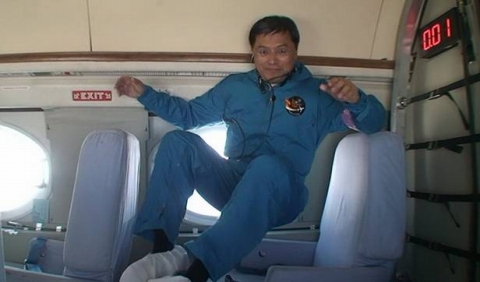This is an archive of information released in the past.
Disclaimer: It may contain broken links or outdated information. Some parts may not function in current web browsers.
*Visit https://humans-in-space.jaxa.jp/en/ for the latest information.

Parabolic Flight Experience
On Monday March 26th 2012, I flew on the JAXA parabolic flight at the Nagoya airport, Japan.
This is my first experience on a microgravity flight aboard the official parabolic flight aircraft, Gulfstream II operated by Diamond Air Services.
The experience reminded me of my private pilot training back in 1975 during the stall-and-spin test flying when my back pressed tight against the seatback while my face was looking at the spinning ground and getting closer and closer.
At the end of the spinning aircraft, I leveled off and pulled the plane up for the recovery with a 2-G pull-up.
The main difference is I was a passenger this time and had to endure fourteen cycles of the 2-G and zero-G flight.
To my surprise, it felt better during the microgravity than the 2-G or even 1-G of normal gravity.
By the eleven cycle, I started to feel some dizzyness and wondering if it would get any worse.
It didn't get any worse so I pressed on and enjoyed the rest of the flight.
At the end of the flight I went up to the cockpit and congratulated both pilots for their wonderful flying skills.
I appreciated very much their skills and professionalism in flying the parabolic flight profiles which is not easy to perform for most pilots.

The 20-sec microgravity duration on each cycle is such a short time for researchers to conduct their experiment.
Now, I see the significant of simple design with minimum operation steps to ensure its success.
At NSTDA, we had helped students on all five successful parabolic flight experiment from the design, construction, verification and testing including packing and shipping.
With my experience on this microgravity flight, we will improve our parabolic flight experiment development for Thailand.
Currently NSTDA has seen an increase in the number of parabolic flight experiment application.
We hope to continue sending Thai students to Japan for this invaluable parabolic flight program.
All Thai students that involved on this program appreciate it very much.
Some of them decided to further their study in Japan rather than in the U.S.

Sawat Tantiphanwadi
April 13, 2012
Here are some of the news generated to date in Thailand.
2) RYT9
3) Banmuang
4) NSTDA
5) Meedee
A documentary video of this mission will be broadcasted on Thai PBS channnel.
| Copyright 2007 Japan Aerospace Exploration Agency | Site Policy |
